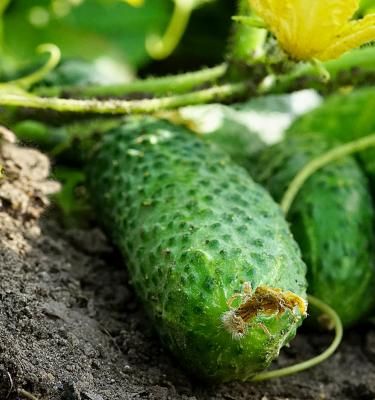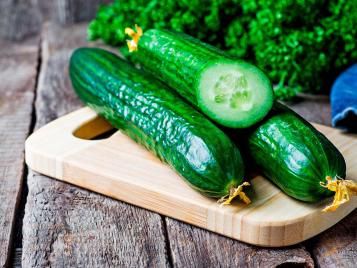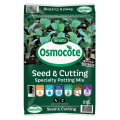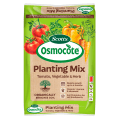

The Ultimate Guide to Growing Cucumbers
Delicious in salads and sandwiches, the crisp, sweet crunch of a cucumber is one of the joys of summer. Growing cucumbers takes a little care and attention but the results are well worth the effort.
To learn how to grow cucumbers, follow our essential guide. Soon your summer salads will be sweet, delicious and super-satisfying.
Growing cucumbers in Australia
The cucumber growing season in Australia depends on your location and the temperature. You should plant cucumbers between September and January in temperate climates, between July and March in the subtropics and October and December in cold climates.
So, when should you pick cucumbers in Australia? Make sure you harvest cucumbers between December and March in temperate climates. This should be done between December and February in cool climates and from September to April in tropics and subtropics.
Choosing the best cucumbers to grow
Growing cucumbers starts with choosing which varieties to grow.
Cucumbers may be smooth-skinned or with ridges and bumps – the exterior appearance has no bearing on flavour or vigour.
There are three main varieties of cucumber grown in Australia. They are:
- Lebanese – the most popular; generally smooth skinned and seedless
- Continental – the longest type with fruit up to 40cm in length
- Apple – rounded, usually white skinned although there are some green varieties and very crunchy
There are many named varieties available of all three types – check your local garden centre or seed supplier for those best suited to your particular location.
What you'll need to start growing cucumbers
To begin your cucumber-growing journey, you will need:
- 9cm pots for sowing seeds
- Seed raising potting mix
- Spade
- Compost or soil improver to dig into garden soil

When to sow your cucumber seeds
You can start your cucumbers off by sowing the seeds in pots. They can be also sown directly into the soil as soon as the soil is warm enough in cool and temperate regions and at the end of the hot, dry season in the tropics. They need a sunny spot protected from strong winds and good soil.

How to grow cucumbers from seed
- Fill 9cm pots with seed raising mix.
- Using the dibber (or a pencil), make a hole 2.5cm deep in the centre of the pot.
- Sow one seed per pot, placing it in the hole on edge rather than flat. This reduces the risk of the seed rotting.
- Cover with mix and water well.
When sowing cucumber seeds directly into the garden, sow 2.5cm deep, as for pots.
How and when to plant cucumbers
Cucumbers that have been sown into individual pots can be planted out into the garden when they are sturdy enough to be handled and when soil and weather conditions are conducive to good growth. You want to be sure the temperature won’t drop below 12-15°C and choose a warm, sunny, sheltered spot.
Harden the seedlings off for a week first by placing them outside in their pots during the day and giving them some protection at night.
Before planting out cucumbers, prepare the soil by digging in potting mix or soil improver, then scatter a quality vegetable and herb fertiliser over the soil at the recommended rate and rake it in.
Plant seedlings 90cm apart and water well. You don’t need to provide supports for them unless you are trying to save space – they will grow happily sprawling across the ground.
How to care for your cucumbers
The key to growing cucumbers is not to stress the plants while they are growing, as this will make the fruits taste bitter. Follow these tips for the best harvest:
- Water regularly, keeping the soil moist but not wet.
- To reduce the risk of fungal disease, keep the leaves of the plants dry.
- Once flowers appear, feed the plants fortnightly with Scotts Osmocote Pour+Feed for Tomatoes & Herbs
- Pinch out the new leaves at the tips of growing shoots when the main stem has produced seven leaves to encourage the plants to put all their energy into producing fruit rather than foliage.
- Pinch out any flowerless side shoots once they have produced seven leaves.

How to pollinate cucumbers
When it comes to pollination, cucumbers (like pumpkins, squash and zucchinis) have a few quirks. One of these is that they produce separate male and female flowers.
It’s easy to tell the male flowers from the female because the male flowers are on thin stems, while the stems of female flowers look like tiny cucumbers (which is what they will develop into).
Some cucumber plants have been bred to produce only female flowers, and these are called all-female plants. Other cucumbers produce both male and female flowers on the same plant.
In the garden veggie patch, cucumbers produce both male and female flowers on the same plant. They need to be pollinated in order to produce fruit. Don’t remove any flowers from the plants, just let the pollinating insects do their thing.

When to pick cucumbers
Harvest cucumbers at any stage once the fruits are between 15-20 cm long. Use a sharp knife to cut them from the plant. Pick frequently to encourage the plant to produce more flowers and more fruits.
Once you’ve tasted your own cucumbers fresh from the plant, you’ll never look back.
Common cucumber diseases and pests
| Powdery mildew |
Powdery mildew is a common disease of cucumbers. This is a fungal disease that appears as a white powdery deposit on cucumber leaves, stunting growth and causing leaves to shrivel. Drought-stressed plants are more susceptible to this disease.
|
| Cucumber mosaic virus |
Cucumber mosaic virus can cause yellow leaves on cucumber plants, with a characteristic ‘mosaic’ patterning. Affected plants produce few or no flowers, and any cucumbers that develop are small and inedible.
|
| Cucumber plants wilting |
If cucumber plants start to wilt suddenly despite normal watering, this may be due to sudden changes in temperature such as a strong cool change or an exceptionally hot day.
|



